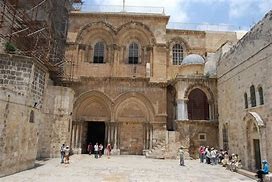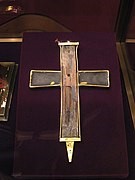PART XIII: Some History of Zion, Jerusalem’s Temple Mount, and Jerusalem’s Church of the Holy Sepulchre
The church post World War II

In 1948, Jerusalem was divided between Israel and Jordan and the Old City with the church were made part of Jordan. In 1967, Israeli forces captured East Jerusalem in the Six Day War, and that area has remained under Israeli control ever since. Under Israeli rule, legal arrangements relating to the churches of East Jerusalem were maintained in coordination with the Jordanian government. The dome at the Church of the Holy Sepulchre was restored again in 1994-1997 as part of extensive modern renovations that have been ongoing since 1959. During the 1970-1978 restoration works and excavations inside the building, and under the nearby Muristan bazaar, it was found that the area was originally a quarry, from which white meleke limestone was struck.
Chapel of St. Vartan
East of the Chapel of Saint Helena, the excavators discovered a void containing a 2nd century drawing of a Roman pilgrim ship, two low walls supporting the platform of Hadrian’s 2nd century temple, and a higher 4th century wall built to support Constantine’s basilica. After the excavations of the early 1970s, the Armenian authorities converted this archaeological space into the Chapel of Saint Vartan, and created an artificial walkway over the quarry on the north of the chapel, so that the new chapel could be accessed–by permission–from the Chapel of Saint Helena.
After seven decades of being held together by steel girders, the IAA [Israel Antiquities Authority] declared the visibly deteriorating Aedicule structure unsafe. A restoration of the Aedicu-le was agreed upon and executed from May, 2016-March, 2017. The existence of the original lime-stone cave walls within the Aedicule was confirmed, and a window was created to view this from the inside. The presence of moisture led to the discovery of an underground shaft resembling an escape tunnel carved into the bedrock, apparently to lead from the tomb. For the first time since at least 1555, on October 26, 2016, marble cladding protecting the supposed burial bed of Jesus was removed. Members of the National Technical University of Athens were present.
A layer of debris was cleared during the next day, and a partially broken marble slab with a Crusader-style cross carved on it was revealed. By the night of October 28, the original limestone burial bed was shown to be intact. The tomb was resealed shortly thereafter. Mortar from just above the burial bed was later dated to the mid-4th century.
This finding was on the order of the events surrounding the Shroud of Turin: The Shroud–a linen cloth that tradition associates with the crucifixion and burial of Jesus–has undergone numerous scientific tests, the most notable of which is radiocarbon dating, in an attempt to determine the relic’s authenticity. In 1988, scientists at three separate laboratories dated samples from the Shroud to a range of 1260–1390 CE, which coincides with the first certain appearance of the shroud in the 1350s and is much later than the burial of Jesus in 30 or 33 CE. Aspects of the 1988 test continue to be debated. Despite some technical concerns that have been raised about radiocarbon dating of the Shroud, no radiocarbon-dating expert has asserted that the dating is substantially unreliable.
Also–it is worth noting–the slivers of cedar, pine, and cypress, wood from the true cross were reverently taken all around the Christian world and preserved for pilgrims to see and to marvel over. Fragments of the Cross were broken up, and the pieces were widely distributed; in 348 CE, in one of his Catecheses, Cyril of Jerusalem remarked that the “Whole Earth is full of the relics of the Cross of Christ” and, in another, “The holy wood of the Cross bears witness, seen among us to this day, and from this place now almost filling the whole world, by means of those who in faith take portions from it.”
By the end of the Middle Ages so many churches claimed to possess relics of the True Cross, that John Calvin is famously said to have remarked that there was enough wood in them to fill a ship. He said: There is no abbey so poor as not to have a specimen. In some places there are large fragments, as at the Holy Chapel in Paris, at Poitiers, and at Rome, where a good-sized crucifix is said to have been made of it. In brief, if all the pieces that could be found were collected together, they would make a big ship-load. Yet the Gospel testifies that a single man was able to carry it.
Four cross particles–of ten particles with surviving documentary provenances by Byzantine emperors–from European churches: Santa Croce in Rome, Caravaca de la Cruz, Notre Dame in Paris, Pisa Cathedral and Florence Cathedral, were microscopically examined. The careful scientific conclusion was that “The pieces came all together from olive.” It is therefore altogether likely that many alleged pieces of the True Cross are forgeries, created by traveling merchants in the Middle Ages, during which period a thriving trade in manufactured relics existed. One author opined that there had been enough wood from Christ’s true cross spread around the world to build the Spanish Armada.

During church renovations in 2022, a stone slab covered in modern graffiti was moved from a wall, revealing Cosmatesque-style decoration [a style of geometric decorative inlay stonework typical of the architecture of Medieval Italy, and especially of Rome and its surroundings] on one face. According to an IAA archaeologist, the decoration was once inlaid with pieces of glass and fine marble; it indicates that the relic was the front of the church’s high altar from the Crusader era [c. 1149], which was later used by the Greek Orthodox until being damaged in the 1808 fire.
South of the parvis, opposite the church:
• Broken columns—once forming part of an arcade—stand opposite the church, at the top of a short descending staircase stretching over the entire breadth of the parvis. In the 13th century, the tops of the columns were removed and sent to Mecca by the Khwarezmids.
• The Gethsemane Metochion, a small Greek Orthodox monastery (metochion). On the eastern side of the parvis, south to north:
• The Monastery of St Abraham (Greek Orthodox), next to the Suqed-Dabbagha entrance to the parvis.
• The Chapel of St John the Evangelist (Armenian Orthodox)
• The Chapel of St Michael and the Chapel of the Four Living Creatures (both are dispu-ted between the Copts and Ethiopians), giving access to Deir es-Sultan (also disputed), a rooftop monastery surrounding the dome of the Chapel of St Helena.
North of the parvis, in front of the church façade or against it:
• Chapel of the Franks (Chapel of Our Lady of Sorrows): a blue-domed Roman Catho-lic Crusader chapel dedicated to Our Lady of Sorrows, which once provided exclusive access to Calvary. The chapel marks the 10th Station of the Cross (the stripping of Jesu-s’s garments).
• Oratory of St. Mary of Egypt: a Greek Orthodox oratory and chapel, directly beneath the Chapel of the Franks, dedicated to St. Mary of Egypt.
• The tomb (including a ledgerstone) of Philip d’Aubigny [Philip Daubeney, d. 1236], a knight, tutor, and royal councilor to Henry III of England and signer of the Magna Carta.
A group of three chapels borders the parvis on its west side. They originally formed the baptistery complex of the Constantinian church.
• The Chapel of St. James the Just (Greek Orthodox),
• The Chapel of St. John the Baptist (Greek Orthodox),
• The Chapel of the Forty Martyrs of Sebaste (Greek Orthodox; at the base of the bell tower).
The 12th century Crusader bell tower is just south of the Rotunda.
According to their own family lore, the Muslim Nuseibeh family has been responsible for opening the door as an impartial party to the church’s denominations already since the 7th century. However, they themselves admit that the documents held by various Christian denominations only mention their role since the 12th century, in the time of Saladin, which is the date more generally accepted. After retaking Jerusalem from the Crusaders in 1187, Saladin entrusted the Joudeh family with the key to the church, which is made of iron and 12 inches long; the Nuseibehs either became or remained its doorkeepers.

